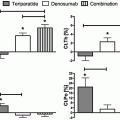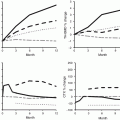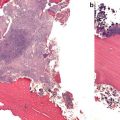Fig. 6.1
Classification of subtrochanteric and femoral shaft fractures
The Use of Large Datasets in the Study of AFF
There are several studies that have evaluated subtrochanteric and femoral shaft (ST/FS) by the International Classification of Disease (ICD) codes , which have allowed large-scale studies of numerous data sources. These data can be used to determine the potential impact of these fractures in terms of providing an upper limit of the number of atypical fractures to expect, since only a small fraction of ST/FS fractures are atypical. However, with this type of database study, it is impossible to determine if the fractures are atypical since there is no radiographic adjudication. In addition, when these databases are used, the results can be impacted by the source of the data, whether there was a restriction on age, exclusion of trauma or other diseases, as well as which ICD codes were used in the analysis. For example, a comparison of 3 studies [8–10] used to evaluate trends in hip fracture rates and ST/FS fractures is found in Table 6.1. Ng used a subanalysis to determine that ST/FS fractures are increasing in women age 60 and older who sustained a fracture with moderate trauma, and this includes falls from standing height [10]. There are differences noted in terms of the database evaluated, age studied, ICD-9 codes utilized, and the exclusions applied as well as the results. An additional problem in studies that use ICD-9 codes for finding fracture cases is that the fracture location could be misclassified. In fact, only 36 % of femoral shaft fractures were correctly identified for their location [11]. However, despite these limitations, many studies have found that the rate of ST/FS fractures have increased recently [10, 12, 13].
Table 6.1
Characteristics of studies evaluating trends in rates of hip fracture and ST/FS fractures
Study author | Age | Data source | ICD 9 codes used | Exclusions | Results |
|---|---|---|---|---|---|
Wang | 50+ | Nationwide inpatient sample (NIS) developed from HCUP by AHRQ Represents 20 % discharges from community hospitals in the USA 1996–2007 (~90 million) | Only subtrochanteric ICD-9-CM: 820.22 primary surgical or replacement | Open fracture also excluded discharges for follow-up visits, procedures for peri-prosthetic fractures, and revision procedures | 31.2 per 100,000 in 1996 to 34.2 per 100,000 in 2007 for only subtrochanteric (9.6 % increase) |
Nieves | 65+ | National Center for Health Statistics 1996–2006 ~2.7 million records over 10 years and MarketScan 2002–2006 (~15 million) | Subtrochanteric (820.22), femoral shaft (including 821.00, unspecified part of femur; 821.01, shaft), and lower femur (including 821.20, lower end, unspecified; 821.21, condyle; 821.22, epiphysis, lower; 821.23, supracondylar; and 821.29, other) | Open fracture and Paget’s disease (ICD-9 731.0) and malignancy (ICD-9 140-208) | Incidence of subtrochanteric and femoral shaft fractures combined was <25/100,000 person-years Stable over time evaluated |
Ng | All ages | Olmsted County | ICD-9 codes 820–821 X-ray or report reviewed for location and level of trauma but not for atypia | Subanalysis based on age, level of trauma, or pathologic causes, and location—distal femur, diaphyseal, and subtrochanteric fractures | In women age 60+, moderate and no trauma fractures increased from 40.8 per 100,000 (95 % CI, 29.2–55.3) in 1984–1995 to 76.1 per 100,000 (95 % CI, 61.7–93.0) in 1996–2007 (p = 0.001) |
Several studies have found that subtrochanteric and diaphyseal femur fractures share the epidemiology of classic osteoporosis-related hip fractures in terms of increasing incidence with age and higher rates in females than males [8, 14].
Danish administrative data [15] were queried to investigate the relationship between bisphosphonate use and subtrochanteric or femoral shaft fractures among a large number of alendronate users (n = 39,567) and nonusers (n = 158,268). Alendronate users were more likely to have hip fractures than nonusers (HR, 1.5; 95 % CI, 1.4–1.5). In addition, alendronate users were more likely to have subtrochanteric or femoral shaft fractures (HR, 2.0; CI, 1.8–2.3); however, the risk did not vary with length of bisphosphonate use. Of note, these were not AFF since there was no radiographic review. A similar lack of association between BP use and ST/FS fractures was found in another Danish study using untreated controls and in both a US study and one based on data from Taiwan both of which used other osteoporosis drug users as controls [16–18]. A nested case -control study in Canada did find that BP use for more than 5 years as compared to transient use was associated with ST/FS fracture (OR = 2.7, 95 % CI 1.25, 6.02), although as expected there was a concomitant reduced odds of classic hip fractures [19]. Again, there was no radiographic review, so these were not AFFs.
Risk Factors from Case Reports and Other Studies
Several clinical and radiographic features were identified from numerous case reports and series [20–29] which have helped to differentiate atypical fractures as being distinct from osteoporosis-related, prosthesis-related, or major trauma-related fractures. Asian women appear to represent a greater proportion of persons with AFF as compared to the population proportion [30, 31]. One of these features is now included in the minor features of AFF prodromal pain in the thigh or leg for weeks or months prior to the fracture [20, 24, 25, 32, 33], lack of trauma precipitating a fracture [20, 21, 24, 25], bilaterality in approximately 30 % (either simultaneous or sequential) [21, 25, 27, 28] and typically at the same location in the contralateral leg [34], transverse fractures [24], cortical hypertrophy or thickness [25], stress reaction on the affected and/or unaffected side [20, 22, 24, 25, 27], and poor fracture healing [25, 26]. Other features identified with AFF include use of proton pump inhibitors , steroid therapy , in addition to the bisphosphonate [22, 25, 28, 35–38], and adherence to bisphosphonates [39] and other antiresorptive agents [38, 40–42], although in some cases there was prior bisphosphonate use. Normal or low bone mass but not osteoporosis in the hip region [28, 43–45] has also been reported. Comorbid conditions (e.g., vitamin D deficiency, rheumatoid arthritis, hypophosphatasia) have also been related to AFF [45, 46]. A recent study of 11 AFFs compared to those with typical femoral fractures (n = 58) identified hypocalcemia due to latent hypoparathyroidism as primary risk factor for AFF; younger age, higher BMI, early menopause, and less compromised BMD may also influence the development of AFF [47]. Structural features and hip geometry [34, 48] may also be important, and in fact 12 elderly women had AFF associated with bowing deformity, and only 6 of 12 had prior bisphosphonate use [49]. This is further described in Chap. 7. Although cortical thickening was thought to relate to long-term BP use, this is not true, and increased subtrochanteric femoral cortical thickening may instead be a risk factor. In fact, many AFFs occur at the point of greatest cortical thickening [50, 51]. A registry for AFF would help to identify more commonly underlying features sinc e additional case series are unlikely to continue to be published.
Studies of Atypical Subtrochanteric and Femoral Shaft Fractures with Radiographic Review
The ASBMR Task Force [1] had extensively reviewed the epidemiologic studies concerning AFF, and these studies are found in Table 6.2 [30, 33, 52–61]. Many of these studies found an association between bisphosphonate use and AFF [30, 33, 52–58]. The benefits of bisphosphonates have been estimated to be 100-fold greater than the risk of AFF [38].
Table 6.2
Stu dies of atypical subtrochanteric and femoral shaft fractures with radiograph review
Author/date country | Design/time frame | Population | ST/FS N | AFF criteria | AFFs N (%) | AFFs on BPs N (%) | Incidence rate | Relative risk for BP use OR (95 % CI) | Absolute risk for BP use OR (95 % CI) | Comments |
|---|---|---|---|---|---|---|---|---|---|---|
Lenart, 2009, USA [52] | Retrospective case-control 2000–2007 | PM women admitted to level 1 trauma center in NY with ST/FS # matched by age, race, BMI to 1 IT and 1 FN # excluded GCs and low D levels | 41 | Transverse or oblique orientation. Cortical thickening. “Beaking” of lateral cortex. No kappa: all 3 had to agree | 10 (24) | Hard to calculate | NA | 15.33 (3.1–76.9) | NA | FN/IT# decreased with longer duration of BP use. AFFs associated with longer duration of BP use. Patients with AFFs on BPs were younger (70.4 vs. 82.5) |
Girgis, 2010, Australia [53] | Retrospective case-control 2003–2008 | 152 M + W of any age admitted with ST/FS # | 152 | Lateral transverse or <30° oblique. Fracture line in area of cortical thickening. Medial unicortical beak. Kappa 0.8 | 20 (13) | 17 (85) | NA | 37.4 (12.9–113.3) | NA | Specificity of atypical pattern for BP use 96.7 %. No clear association with duration of BP use. Associated with GC exposure (OR 5.2; 95 % CI, 1.3–31) |
Giusti, 2011, Netherlands [54] | Retrospective cohort case-control 1997–2007 | 906 M + W ≥ 50 admitted with new femur # each ST/FS # matched 1:2 to hip # matched for age, gender | 63 (low energy) | Transverse or short oblique Non-comminuted in an area of thickened cortices Unicortical beaking. Kappa 0.83 | 10 (16) | 5 (50) | NA | 17.0 (2.6–113.3) | NA | No change in frequency of IT/FN or ST/FS fractures over 11 years. No difference in duration of BP between AFFs and ST/FS. AFFs associated with GC exposure, but not significant |
Schilcher, 2011, Sweden [55] | Retrospective cohort case-control 2008 | 12,777 women ≥ 55 of whom 3515 admitted with proximal femur # in 2008 59 women with AFFs matched to 263 women with # at similar site representative of women vulnerable to # | 1234 | Transverse. Initiated on lateral side. Non-comminuted. Thickened lateral cortex at fracture site. No kappa | 59 (5) | 46 (78) | Ever use of BP 5.5/10,000 patient-year 1.9/10,000 for <1–1.9 years of use 8.4/10,000 for ≥2.0 years | Cohort: age-adjusted 47.3 (25.6, 87.3). Case-control: multivariate-adjusted 33.3 (14.3–77.8) | 5 per 10,000 patient-years (4–7) | AFFs associated with longer duration of BP use. Risk diminished by 70 % per year after last use. No association with GC or PPI exposure. Drug use only captured from 2005 onward; uncaptured prior BP exposure may have inflated rates |
Thompson, 2012, UK [56] | Retrospective case series no controls 2008–2010 | 3515 M + W admitted with proximal femur fracture | 407 | Simple transverse fracture line in a region of cortical hypertrophy. No kappa | 27 (7) | 22 (81) | NA | N/A | NA | 30 % of patients with AFFs were on GCs. Mean duration of BP use 4.6 years (0.4–12.1) |
Feldstein, 2012, USA [57] | Retrospective cohort case-control 1996–2009 | W ≥ 50; M ≥ 65 KPNW members 5034 new femur # All qualifying # matched to 300 FN and 300 IT # | 197 femoral shaft # (FSF) with X rays | ASBMR major: ST/FS location. Low trauma. Transverse or short oblique fracture (see comments). Non-comminuted. Kappa 0.62 | AFFM 53 (27) AFF major + minor 22 (11) | Any BP dispenses past 6M AFFM 6 (12) | AFFM: 5.9 per 100,000 person-years (4.6–7.4) | Unadjusted 2.29a (1.12–4.67). Age-adjusted 2.11a (0.99–4.49) | AFFM: 5.9 per 100,000 person-years (4.6–7.4) | Incidence of AFFs with ASBMR major + minor criteria increased by 10.7 % annually and was more strongly associated with BP use and with duration of BP and GC use than AFFs with only AFF Major criteria. These authors designated 35 fractures with angles of <30° as transverse, 43 fractures with angles of 30–60° as short oblique, and also included 3 fractures > 60°. Many would not agree that fractures with angles >30° are atypical |
Incidence based on 1,271,575 person-years of observation with 98,580 people/year | ASBMR minor: Localized periosteal reaction of the lateral cortex (beaking). Thick cortices. Unicortical stress fracture. Kappa 0.84 | AFF major + minor 11 (52) | NA | |||||||
Lo, 2012, USA [30] | Retrospective case-control 2007–2008 | 3078 W ≥ 60 from KPNW with a hip/femur # in 07-8 | 79 | Transverse or short oblique pattern (with a medial spike). Non-comminuted. Lateral cortical thickening at fracture site. No kappa | 38 (48) | 37 (97) | NA | N/A | NA | No definition of short oblique. Bisphosphonate duration longer in AFFs than controls (5.1 vs. 2.3 years). No difference in GC exposure. Patients with AFFs more likely to be Asian |
Dell, 2012, USA [62] | Prospective cohort incidence 2007–2011 | All femur # over 5-year period in 1,835,116 M + W ≥ 45 enrolled in Healthy Bones Program in KPSW 11,466 # reviewed | 4036 | ST/FS location. Transverse or with short oblique extension. Thickening of lateral cortex at fracture site | 142 (4) | 128 (90) Duration of use 1 M–13 Y mean 5.5 ± 3.4 Y | Age-adjusted IR of AFFs with BP use 1.78/100,000 (1.5–2.0) with 0.1–1.9 Y 113.1/100,000 (69.3–156.8) with 8-8.9 Y | N/A | NA | For comparison, IR of all hip fractures in BP-exposed pts at KPSW was 463/100,000 patient-years in those on BPs for 0–1 Y. IR of all hip fractures decreased on BPs out to 5 years (384, 367–400), then stabilized, and was slightly increased after 8–9 years (544/100,000 (522–565). Incidence of AFFs increased markedly with increasing duration of BP use. 49 % of patients with AFFs were Asian. 12 % of patients with AFFs were on GCs |
Meier, 2012, Switzerland [58] | Retrospective case-control cases were 39 AFFs, and 438 controls were patients with “classic” # in same region 1999–2010 | 477 M + W ≥ 50 hospitalized with ST or FS # denominator for IR state population >50 | 477 | Transverse or short oblique. Originating at lateral femoral cortex. Kappa 0.96 | 39 (8) | 32 (82) | Over 12 Y, IR for classic # was 357/1,000,000 p-y and was stable. For AFFs IR was 32/1,000,000 and increased by 10.7 % (+1.2 to +20.3 %; p = 0.03) | Crude OR 66.9 (627.1–165.1). Adjusted OR (Vit D, GCs, PPIs, sex, age) 69.1 (22.8–209.5) | For AFFs IR was 32/1,000,000 and increased by 10.7 % (+1.2 to +20.3 %; p = 0.03) | OR for recurrence in patients with AFF was 42.6 (12.8–142.4) compared to classic #. OR for AFF vs. classic fractures increased with increasing BP duration from 35.1 (10.1–123.6) for <2 years, 46.9 (14.2–154.4) for 2–5 Y, 117.1 (34.2–401.7) for 5–9 Y, 175.7 (30.0–1027.6) for ≥9 Y, compared with no BP use. Mean duration of use 5.1 ± 3.1 Y for AFF vs. 3.3 ± 2.6 Y for classic (p = 0.02) |
Warren, 2012, New Zealand [59] | Retrospective case-control cases were 6 AFFs, and 65 controls were patients with fractures in same region 2003–2008 | 528 M + W ≥ 20 hospitalized with ST or FS #, excluding those associated with coding errors, high trauma, tumors, or other pathology, prostheses, minor comminution | 528 | Thickened cortices. Transverse orientation. Medial spike. Single observer. No kappa
Stay updated, free articles. Join our Telegram channel
Full access? Get Clinical Tree
 Get Clinical Tree app for offline access
Get Clinical Tree app for offline access

|




